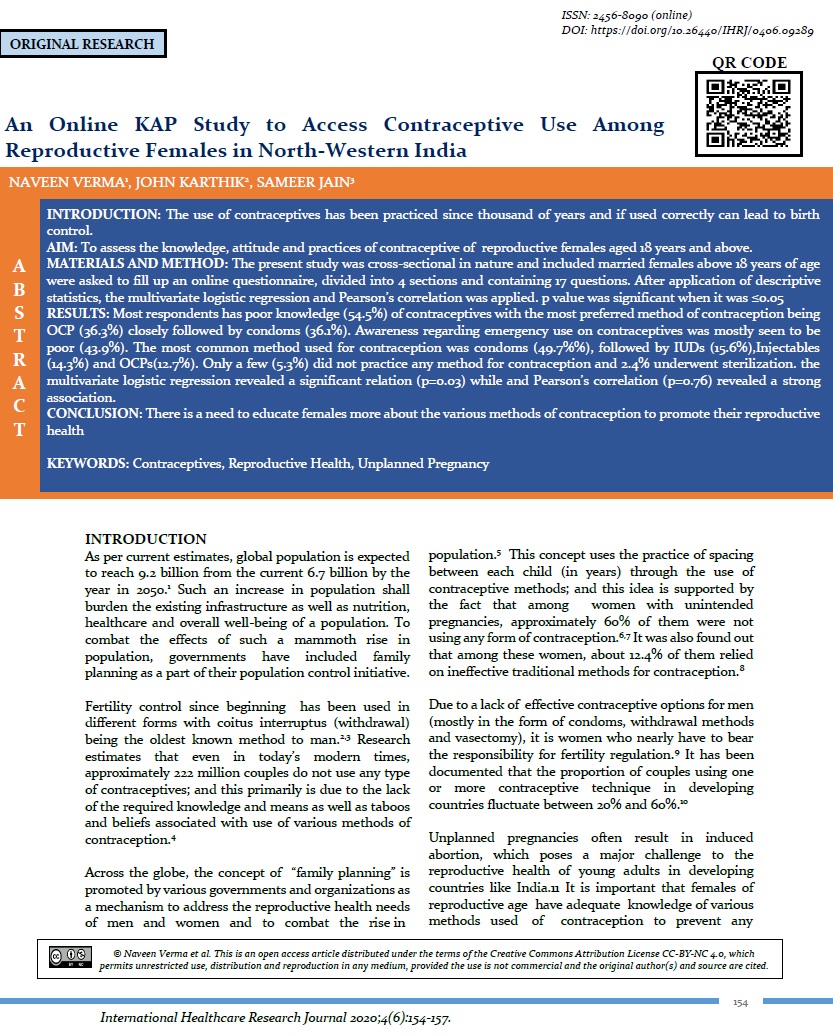An Online KAP Study to Access Contraceptive Use Among Reproductive Females in North-Western India
Abstract
INTRODUCTION: The use of contraceptives has been practiced since thousand of years and if used correctly can lead to birth control.
AIM: To assess the knowledge, attitude and practices of contraceptive of reproductive females aged 18 years and above.
MATERIALS AND METHOD: The present study was cross-sectional in nature and included married females above 18 years of age were asked to fill up an online questionnaire, divided into 4 sections and containing 17 questions. After application of descriptive statistics, the multivariate logistic regression and Pearson’s correlation was applied. p value was significant when it was ≤0.05
RESULTS: Most respondents has poor knowledge (54.5%) of contraceptives with the most preferred method of contraception being OCP (36.3%) closely followed by condoms (36.1%). Awareness regarding emergency use on contraceptives was mostly seen to be poor (43.9%). The most common method used for contraception was condoms (49.7%%), followed by IUDs (15.6%),Injectables (14.3%) and OCPs(12.7%). Only a few (5.3%) did not practice any method for contraception and 2.4% underwent sterilization. the multivariate logistic regression revealed a significant relation (p=0.03) while and Pearson’s correlation (p=0.76) revealed a strong association.
CONCLUSION: There is a need to educate females more about the various methods of contraception to promote their reproductive health
Downloads
References
Hammad AQ, Hashmi A, Syed AR, Jamil AS, Aslam G. Contraceptive methods and factors associated with modern contraceptive in use. J Family Reprod Health. 2010;4(1):41–46.
Ezeh AC, Bongaarts J, Mberu B. Global population trends and policy options. Lancet. 2012;380:142–148.
Aldabbagh RO, Al-Qazaz HK. Knowledge and Practice of Contraception Use Among Females of Child-Bearing Age in Mosul, Iraq. International Journal of Women's Health 2020;12:107–113
Cleland J, Bernstein S, Ezeh A, Faundes A, Glasier A, Innis J. Family planning: the unfinished agenda. Lancet. 2006;368(9549):1810–1827. doi:10.1016/S0140-6736(06)69480-4
Pandey S, Karki S, Pradhan A (2010) Practice of contraceptives. Journal of Institute of Medicine 31: 3-9.
Thapa P, Pokharel N, Shrestha M (2018) Knowledge, Attitude and Practices of Contraception among the Married Women of Reproductive Age Group in Selected Wards of Dharan Sub-Metropolitan City. J Contracept Stud Vol.3 No.3:18
Duze MC, Mohammed IZ. Male knowledge, attitudes, and family planning practices in Northern Nigeria. Afr J Reprod Health 2006;10:53-65.
Oye-Adeniran BA, Adewole IF, Umoh AV, Oladokun A, Ghadegsin A, Ekanem EE, et al. Community-based study of contraceptive behaviour in Nigeria. Afr J Reprod Health 2006;10:90-104
Al-Sekait MA. Prevalence of contraception used among Saudi Arabian women. Saudi Med J. 1999;20(9):687–690.
Bearak J, Popinchalk A, Alkema L, Sedgh G. Global, regional, and subregional trends in unintended pregnancy and its outcomes from 1990 to 2014: estimates from a Bayesian hierarchical model. Lancet Glob Health. 2018;6(4):e380–e389. doi:10.1016/S2214-109X(18)30029-9
Anupama Srivastav, Mohammad Shams Khan, Chitra Rani Chauhan. "Knowledge, Attitude and Practices about Contraceptive among Married Reproductive Females". International Journal of Scientifi c Study. 2014;1(5):2-4.
Osaro BO, Tobin-West CI, Mezie-Okoye MM. Knowledge of modern contraceptives and their use among rural women of childbearing age in Rivers State Nigeria. Ann Trop Med Public Health 2017;10:1043-8
Pegu B, Gaur BPS, Sharma N, Singh AS. Knowledge, attitude and practices of contraception among married women. Int J Reprod Contracept Obstet Gynecol. 2014;3:385-8. 10.5455/2320-1770.ijrcog20140620
Sweya MN, Msuya SE, Mahande MJ, Manongi R. Contraceptive knowledge, sexual behavior, and factors associated with contraceptive use among female undergraduate university students in Kilimanjaro region in Tanzania. Adolesc Health Med Ther. 2016;7:109-115. https://doi.org/10.2147/AHMT.S108531
Haque Md N. Unmet need for contraceptive: the case of married adolescent women in Bangladesh. Int J Curr Res 2010:29-35.

Copyright (c) 2020 Naveen Verma et al.

This work is licensed under a Creative Commons Attribution-NonCommercial 4.0 International License.


